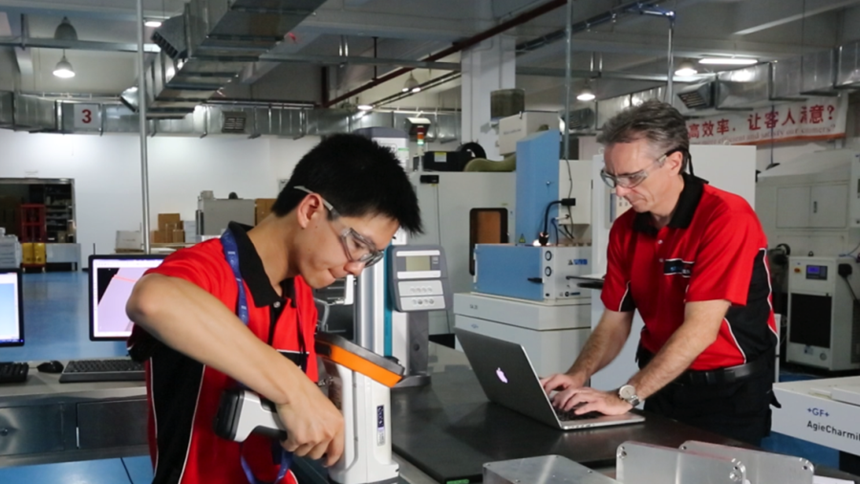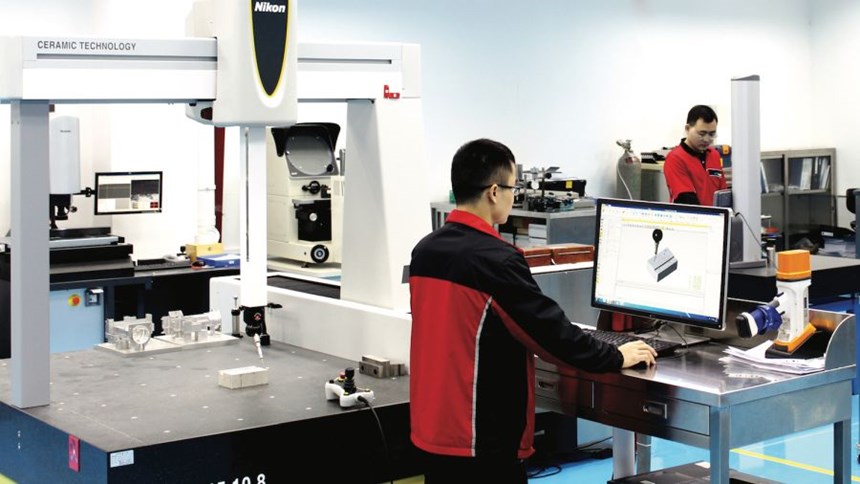Measurement and Testing Protocols for 3D Printing
3D printing combined with CNC machining is a powerful mix that enables the creation of parts unobtainable from using one method alone. However, taking full advantage of both requires special attention to testing and measurement.
Share
Read Next
Establishing careful measurement protocols is always important for any manufacturing job, but it is even more critical when 3D printing parts. Having insight into the limitations of additive manufacturing and the tests that a printed part will undergo may help during the design phase to avoid costly and time-consuming design or engineering revisions late in the production cycle.
Below are five common testing and measurement practices for 3D printing:
1. Raw material identification. There is sophisticated metrology equipment for the testing of bar and plate stock for subtractive manufacturing; however, those same tests don’t work to verify powder for 3D printing. 3D printing starts with refined metal powder that is only available from a relatively small number of suppliers. In some cases, the powder can be supplied directly from the manufacturer of the 3D printer. Since the powder is optimized by the manufacturer for the manufacturer’s printer, it can be used with confidence. However, it is important to make sure the machine is thoroughly cleaned between runs of dissimilar powder types.
2. Pre-printing design and measurement. Before printing, it’s important for the 3D CAD file to be carefully reviewed to ensure that the design is optimized to be compatible with the tolerances of the machine that will be printing it. For example, a printer may require a minimal wall thickness of 0.2 mm, while holes/gaps can be no smaller than 0.4 mm. These parameters are functions of powder size, beam profile and table movement, among other variables. After a part is 3D printed, it will be possible to post-machine it to achieve much closer tolerances, but only on external features. Internal cavities outside the line-of-sight of a straight drill bit or mill cannot be machined. These internal features will remain as-is, which emphasizes the importance of designing a part carefully with the machine’s specifications in mind.
Designs with acute angles or overhangs may also need added supports to make these features when 3D printing. These can be machined off after the part is printed, if the supports are added in places where machine tools, grinders or sanders can reach. Anything too small or inside a convoluted geometry may not be machinable. Careful design consideration at this early stage will save much more time, money and aggravation in the long run.
3. Post-printing measurement. Once a part comes out of the printer, the dimensions should be measured and compared to the original CAD file, but here there are a few caveats. First, the surface finish that’s created through 3D printing is rough, so close tolerances should be ignored at this stage. Second, the part was deliberately oversized in the design. The extra material is needed so it can later be machined away to reach the part’s final dimensions. At this stage, what is important is the correct relative location of all features.
One way to test the relative location of features is to create a 3D map of the printed part using a 3D scanner. This is particularly effective for capturing complex shapes with many points. The resulting 3D map can then be compared to the original CAD drawing to get an immediate visual reference for any potential errors. However, 3D scanners only work for the exterior of the surface, not any hidden internal cavities that 3D printing enables. These cannot be conventionally measured and so their size and location must be inferred from the initial printing file.
This later consideration is crucial when machining features like thin-walled sections of conformal cooling channels. Take off too much metal and the part is ruined, or even worse, can fail in use. In critical applications, it is possible for special labs to perform high-resolution CT scanning to determine the dimensions of interior spaces.
4. Design and measurement for post-machining. After printing and measuring, the part is moved to the CNC machining center. When preparing a 3D-printed part for CNC machining, the measurements obtained through 3D scanning will help determine the best way to hold the piece securely and where to establish reference points for cutting and milling. Therefore, it’s best if the initial printing design was optimized from the beginning to match with the machine on which secondary processes will later be performed.
However, there may still be a certain degree of risk when machining. Why? Because the precise location of hidden internal cavities is not known (as discussed above). The machinist must take great care when cutting the final dimensions on thin-walled sections, which is a problem unique to 3D printing that doesn’t exist when machining from a blank.
5. Final measurement and testing. After machining, there will be a solid finished part and not a bed of powder. So, as with other metal parts, all required mechanical tests can be conducted, such as hardness, tensile strength and surface roughness. Laser-melted 3D metal parts are 99 percent as dense as forged parts, but they will be slightly stronger in the Z axis than the X and Y axes because of the way the powder is laid down.
It’s now possible to perform a complete dimensional measurement of the finished part using a coordinate measuring machine (CMM). The CMM has a massively stable granite table with a very flat surface. A precisely made sapphire crystal mounted on a touch probe assures measurement accuracy. This machine is housed in a climate-controlled room to further reduce temperature-induced measurement variations.
One of the great advantages of the CMM is that it can be programmed to a set of coordinates based on the original CAD drawing. Once programmed, it can then automatically measure multiple parts in succession at the touch of a button and compare those results to original specifications.
Metal 3D printing and CNC machining both have inherent strengths and weaknesses. Getting these two technologies to complement one another requires careful measurement and testing at several stages of production. This strategy is the best way to create next-generation parts and tooling for the most advanced applications.
About the Author
Gordon Styles is the founder and president of Star Rapid (previously known as Star Prototype), a provider of prototyping, rapid tooling and low-volume manufacturing services.
Related Content
AM 101: What Is Hot Isostatic Pressing (HIP)? (Includes Video)
Hot isostatic pressing has long been used for metal castings, but is now being applied as a valuable method for closing porosity in metal 3D printed parts.
Read MoreTop 10 Additive Manufacturing Stories of 2023
Laser powder bed fusion, proprietary AM processes, machining and more made our list of top 10 articles and videos by pageviews this year.
Read MoreAdditive Manufacturing Is Subtractive, Too: How CNC Machining Integrates With AM (Includes Video)
For Keselowski Advanced Manufacturing, succeeding with laser powder bed fusion as a production process means developing a machine shop that is responsive to, and moves at the pacing of, metal 3D printing.
Read MoreHow Does Heat Treating Affect Machining Considerations for a Metal 3D Printed Part?
This picture of part distortion in additive manufacturing illustrates the kind of effects that part design or machining stock allowances need to anticipate.
Read MoreRead Next
Hybrid Additive Manufacturing Machine Tools Continue to Make Gains (Includes Video)
The hybrid machine tool is an idea that continues to advance. Two important developments of recent years expand the possibilities for this platform.
Read MoreAt General Atomics, Do Unmanned Aerial Systems Reveal the Future of Aircraft Manufacturing?
The maker of the Predator and SkyGuardian remote aircraft can implement additive manufacturing more rapidly and widely than the makers of other types of planes. The role of 3D printing in current and future UAS components hints at how far AM can go to save cost and time in aircraft production and design.
Read More4 Ways the Education and Training Challenge Is Different for Additive Manufacturing
The advance of additive manufacturing means we need more professionals educated in AM technology.
Read More
























